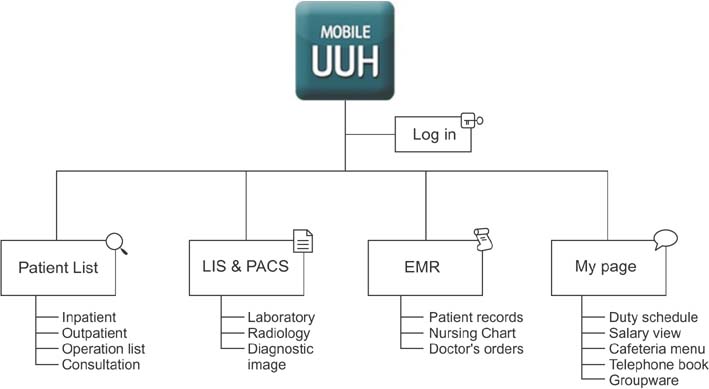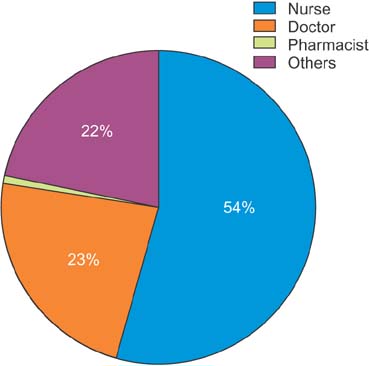Healthc Inform Res.
2015 Oct;21(4):292-298. 10.4258/hir.2015.21.4.292.
Early Experiences with Mobile Electronic Health Records Application in a Tertiary Hospital in Korea
- Affiliations
-
- 1Department of Emergency Medicine, Ulsan University Hospital, University of Ulsan College of Medicine, Ulsan, Korea. korean.er.md@gmail.com
- 2Department of Management Information System, Ehwa School of Business, Ehwa Womans University, Seoul, Korea.
- 3Computational Team, Ulsan University Hospital, University of Ulsan College of Medicine, Ulsan, Korea.
- KMID: 2166879
- DOI: http://doi.org/10.4258/hir.2015.21.4.292
Abstract
OBJECTIVES
Recent advances in mobile technology have opened up possibilities to provide strongly integrated mobile-based services in healthcare and telemedicine. Although the number of mobile Electronic Health Record (EHR) applications is large and growing, there is a paucity of evidence demonstrating the usage patterns of these mobile applications by healthcare providers. This study aimed to illustrate the deployment process for an integrated mobile EHR application and to analyze usage patterns after provision of the mobile EHR service.
METHODS
We developed an integrated mobile application that aimed to enhance the mobility of healthcare providers by improving access to patient- and hospital-related information during their daily medical activities. The study included mobile EHR users who accessed patient healthcare records between May 2013 and May 2014. We performed a data analysis using a web server log file analyzer from the integrated EHR system. Cluster analysis was applied to longitudinal user data based on their application usage pattern.
RESULTS
The mobile EHR service named M-UMIS has been in service since May 2013. Every healthcare provider in the hospital could access the mobile EHR service and view the medical charts of their patients. The frequency of using services and network packet transmission on the M-UMIS increased gradually during the study period. The most frequently accessed service in the menu was the patient list.
CONCLUSIONS
A better understanding regarding the adoption of mobile EHR applications by healthcare providers in patient-centered care provides useful information to guide the design and implementation of future applications.
Keyword
MeSH Terms
Figure
Reference
-
1. Weinstein RS, Lopez AM, Joseph BA, Erps KA, Holcomb M, Barker GP, et al. Telemedicine, telehealth, and mobile health applications that work: opportunities and barriers. Am J Med. 2014; 127(3):183–187.
Article2. Burdette SD, Herchline TE, Oehler R. Surfing the web: practicing medicine in a technological age: using smartphones in clinical practice. Clin Infect Dis. 2008; 47(1):117–122.
Article3. Lottridge DM, Chignell M, Danicic-Mizdrak R, Pavlovic NJ, Kushniruk A, Straus SE. Group differences in physician responses to handheld presentation of clinical evidence: a verbal protocol analysis. BMC Med Inform Decis Mak. 2007; 7:22.
Article4. Choi W, Park MA, Hong E, Kim S, Ahn R, Hong J, et al. Development of mobile electronic health records application in a secondary general hospital in Korea. Healthc Inform Res. 2013; 19(4):307–313.
Article5. Destailleur L. AWStats logfile analyzer documentation [Internet]. Boulogne Billancourt, France: NLTechno;c2015. cited at 2015 Oct 1. Available from: http://awstats.sourceforge.net/docs/.6. Piek J, Hebecker R, Schutze M, Sola S, Mann S, Buchholz K. Image transfer by mobile phones in neurosurgery. Zentralbl Neurochir. 2006; 67(4):193–196.
Article7. Singh J. 5 Testing approaches for making successful mobile apps [Internet]. place unknown: publisher unknown;2015. cited at 2015 Jul 9. Available from: https://axelerant.com/5-ways-win-mobile-application-testing/.8. Faudree B. Security and privacy in mobile health [Internet]. New York (NY): The Wall Street Journal;2013. cited at 2015 Sep 22. Available from: http://deloitte.wsj.com/cio/2013/08/06/security-and-privacy-in-mobile-health/.9. Benton L. Marrying the BYOD phenomenon to HIPAA compliance [Internet]. Chicago (IL): Healthcare Information and Management Systems Society;2013. cited at 2015 Sep 22. Available from: http://www.himss.org/ResourceLibrary/GenResourceDetail.aspx?ItemNumber=18909.10. Wu RC, Morra D, Quan S, Lai S, Zanjani S, Abrams H, et al. The use of smartphones for clinical communication on internal medicine wards. J Hosp Med. 2010; 5(9):553–559.
Article11. Kang S. Factors influencing intention of mobile application use. Int J Mob Commun. 2014; 12(4):360–379.
Article12. Centers for Medicare and Medicaid Services. Selecting a development approach [Internet]. Washington (DC): Department of Health & Human Services;2008. cited at 2015 Aug 18. Available from: https://www.cms.gov/Research-Statistics-Data-and-Systems/CMS-Information-Technology/XLC/Downloads/SelectingDevelopmentApproach.pdf.13. Cristiano JJ, Liker JK, White CC III. Key factors in the successful application of quality function deployment (QFD). IEEE Trans Eng Manag. 2001; 48(1):81–95.
Article14. Zaidan BB, Zaidan AA, Mat Kiah ML. Impact of data privacy and confidentiality on developing telemedicine applications: a review participates opinion and expert concerns. Int J Pharmacol. 2011; 7(3):382–387.
Article15. World Health Organization. mHealth: new horizons for health through mobile technologies. Geneva, Switzerland: World Health Organization;2011.16. eMarketer. Smartphone users worldwide will total 1.75 billion in 2014 [Internet]. New York (NY): eMarketer;2014. cited at 2015 Jul 19. Available from: http://www.emarketer.com/Article/Smartphone-Users-Worldwide-Will-Total-175-Billion-2014/1010536.17. Rainie L. Internet, broadband, and cell phone statistics [Internet]. Washington (DC): Pew Research Center;2010. cited at 2015 Jul 18. Available from: http://www.pewinternet.org/2010/01/05/internet-broadband-and-cell-phone-statistics/.18. Venta L, Isomursu M, Ahtinen A, Ramiah S. "My phone is a part of my soul" - how people bond with their mobile phones. In : Proceedings of the 2nd International Conference on Mobile Ubiquitous Computing, Systems, Services and Technologies (UBICOMM2008); 2008 Sep 29-Oct 4; Valencia, Spain. p. 311–317.19. Boulos MN, Wheeler S, Tavares C, Jones R. How smartphones are changing the face of mobile and participatory healthcare: an overview, with example from eCAALYX. Biomed Eng Online. 2011; 10:1–14.
Article20. Scherr D, Zweiker R, Kollmann A, Kastner P, Schreier G, Fruhwald FM. Mobile phone-based surveillance of cardiac patients at home. J Telemed Telecare. 2006; 12(5):255–261.
Article21. Rubel P, Fayn J, Nollo G, Assanelli D, Li B, Restier L, et al. Toward personal eHealth in cardiology: results from the EPI-MEDICS telemedicine project. J Electrocardiol. 2005; 38:4 Suppl. 100–106.
Article22. Free C, Phillips G, Felix L, Galli L, Patel V, Edwards P. The effectiveness of M-health technologies for improving health and health services: a systematic review protocol. BMC Res Notes. 2010; 3:250.
Article23. Kallander K, Tibenderana JK, Akpogheneta OJ, Strachan DL, Hill Z, ten Asbroek AH, et al. Mobile health (mHealth) approaches and lessons for increased performance and retention of community health workers in low- and middle-income countries: a review. J Med Internet Res. 2013; 15(1):e17.
Article24. Luxton DD, McCann RA, Bush NE, Mishkind MC, Reger GM. mHealth for mental health: integrating smartphone technology in behavioral healthcare. Prof Psychol. 2011; 42(6):505–512.
Article25. Lehoux P, Sicotte C, Denis JL, Berg M, Lacroix A. The theory of use behind telemedicine: how compatible with physicians' clinical routines? Soc Sci Med. 2002; 54(6):889–904.
- Full Text Links
- Actions
-
Cited
- CITED
-
- Close
- Share
- Similar articles
-
- Development of Mobile Electronic Health Records Application in a Secondary General Hospital in Korea
- Development of Mobile Platform Integrated with Existing Electronic Medical Records
- Usability of Academic Electronic Medical Record Application for Nursing Students' Clinical Practicum
- Nurses’ Experiences with the Use of Electronic Nursing Record: A Qualitative Study
- Pitfalls and Security Measures for the Mobile EMR System in Medical Facilities







